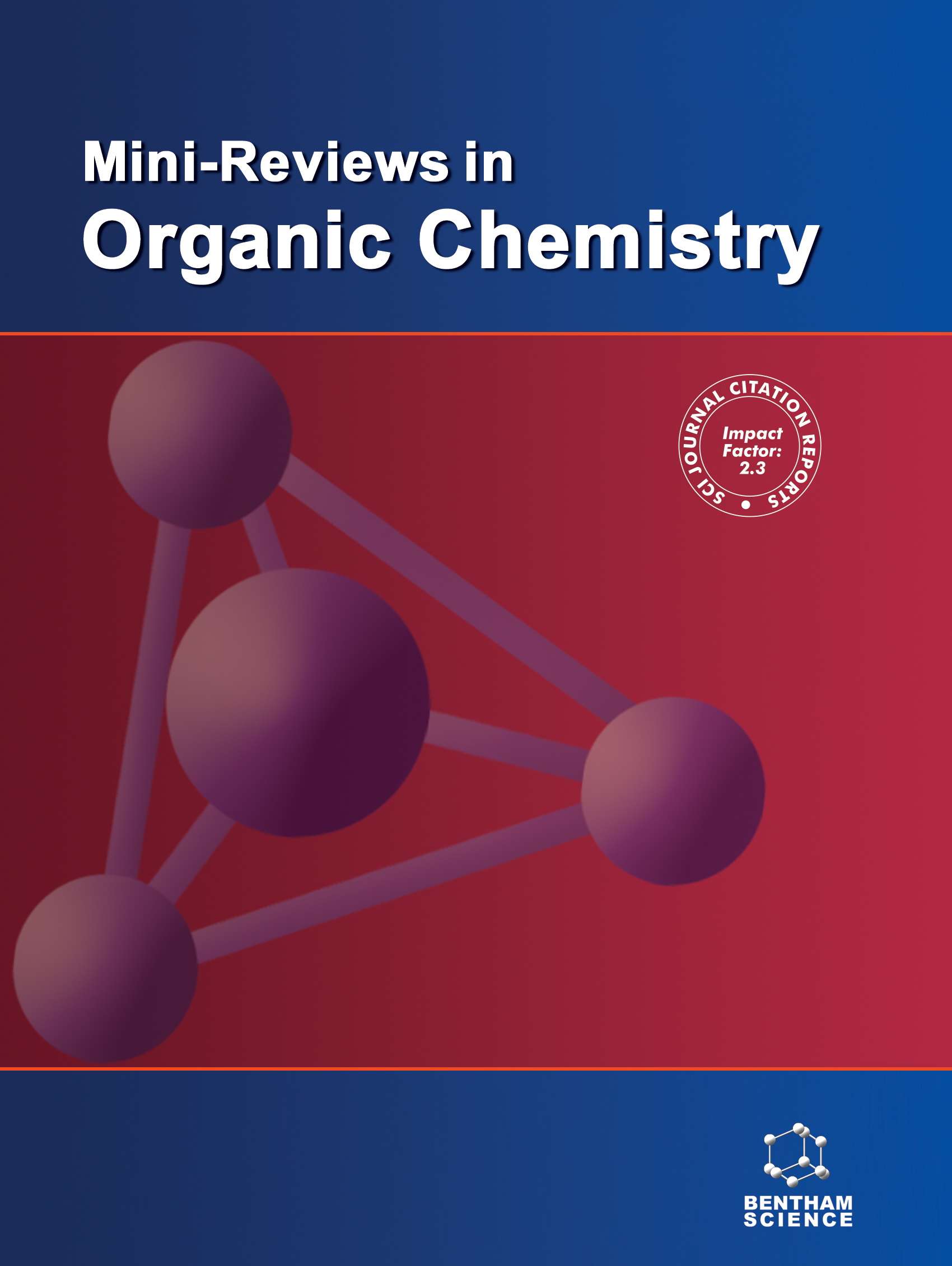Mini-Reviews in Organic Chemistry - Volume 6, Issue 1, 2009
Volume 6, Issue 1, 2009
-
-
Chiro-Inositols in Organic Synthesis
More LessAuthors: J. Singleton and J. O. HobergD- and L-chiro inositols are the enantiomeric pair of carbocyclic carbohydrates obtained from naturally occurring pinitol and quebrachitol. As apposed to well-known sugars that contain a ring oxygen, an anomeric carbon and a primary alcohol, these carbohydrates are comprised of only six secondary alcohols, no ring oxygen and hence no anomeric position. This leads to an inherent complexity and their use as synthetic precursors, chiral ligands and chiral auxiliaries have grown as methods to overcome this complex nature have been developed. Strategies for selective alcohol protection, synthetic transformations, their use in asymmetric synthesis and NMR spectroscopy are discussed in this mini-review.
-
-
-
Homogeneous CrVI-Catalyzed Benzylic, Allylic and Propargylic Oxidations by tert- Butyl Hydroperoxide
More LessBy J. MuzartEnvironmental factors urge to use catalytic rather than stoichiometric oxidation methods. Over the last thirty years, we have reported a large panel of Cr-catalyzed oxidations. This mini-review concerns the benzylic, allylic and propargylic oxidations using CrVI catalysts and t-BuOOH under homogeneous conditions, and summarizes our results and those of the literature.
-
-
-
Recent Applications of Click Chemistry for the Synthesis of Radiotracers for Molecular Imaging
More LessAuthors: Constantin Mamat, Theres Ramenda and Frank R. WuestClick chemistry has received considerable attention as powerful modular synthesis approach, which has found numerous applications in many areas of modern organic chemistry, drug discovery and material science. Recently, click chemistry, and in particular the copper-mediated 1,3-dipolar [3+2] cycloaddition between azides and alkynes, has also entered the field of radiopharmaceutical sciences. This review addresses the recent developments of click chemistry for the synthesis of various radiotracers for molecular imaging purposes. Click chemistry-based radiotracers that will be covered include peptides and small organic molecules containing the short-lived positron emitter fluorine-18, and the gamma-emitters technetium-99m, indium-111, and iodine-125.
-
-
-
Recent Progress on Synthesis of Fluorescein Probes
More LessAuthors: Yousheng Duan, Ming Liu, Wei Sun, Min Wang, Shangzhong Liu and Qing X. LiAfter its first synthesis in 1871, fluorescein and its derivatives have been used as a powerful tool for molecular and cellular studies in biology, molecular biology, interactions between ligands and macromolecules, for drug discovery and environmental research. In recent 20 years, research attention has been paid particularly to synthesis and separation of fluorescein derivatives having various linker groups. This mini-review briefly summarizes synthesis of fluorescein derivatives for improving their chemical, fluorescent and biological properties and conjugation suitability.
-
-
-
Enzyme-catalyzed Synthesis and Degradation of Biopolymers
More LessAuthors: Tomohiro Hiraishi and Seiichi TaguchiThe synthesis and degradation of biopolymers are cardinal reactions that take place to maintain homeostasis in biosystems. Fundamental biological reactions can be reproduced in vitro by means of enzyme-mediated processes. Recently, bioprocesses have been extensively adopted to synthesize representative biopolymers, including aliphatic polyesters, e.g., polyhydroxyalkanoate (PHA). In particular, the protein engineering of enzymes involved in PHA synthesis has made a great impact on the tailor-made synthesis of polymer materials with high performance. Biopolymers can also be synthesized in vitro by enzyme-catalyzed polymerization using synthetic enzymes and depolymerase-mediated reverse reactions. We will describe these advanced topics from the viewpoint of the boundary field between chemistry and biotechnology.
-
-
-
Photophysical and Optical Limiting Properties of Axially Modified Phthalocyanines
More LessAuthors: Yu Chen, Lili Gao, Miao Feng, Lingling Gu, Nan He, Jun Wang, Yasuyuki Araki, Werner J. Blau and Osamu ItoAs one of the most investigated organic compounds, phthalocyanines (Pcs) exhibit a stronger optical limiting response that can be used to protect human eyes, optical elements, and sensors from intense laser pulses, however, they tend to aggregate at high concentration. This aggregation usually adds relaxation pathways, shorten the excited state lifetime, and reduce the effective nonlinear absorption. A best strategy for reducing the intermolecular interactions between Pc molecules is to introduce more or less bulky axial substituents with which it would be expected to alter the electronic structure of the Pc compounds, to introduce a dipole moment perpendicular to the macrocycle, and to alter both intermolecular interactions as well as spatial relationships between neighboring molecules. As a result, a whole series of new highly soluble axially substituted MPc (M= In, Ga, Ti) compounds have been synthesized by us in recent years. Of interest is that their limiting response can be tailored over a very broad range due to the high architectural flexibility of the Pc structure. Future work will be focused on in-depth studies of the Pc-based solution and solid state systems to provide a detailed understanding of the factors affecting the optical limiting response.
-
-
-
Heterocycles from Trifluoromethanesulfonamide: Formation and Structure
More LessAuthors: Bagrat A. Shainyan and Vladimir I. MeshcheryakovSulfonamides are capable of condensing with different carbonyl compounds to form heterocycles. Among other sulfonamides, trifluoromethanesulfonamide is of special interest because of its highest NH-acidity though until recently nothing has been known of its condensation with carbonyl compounds. The focus of the present review is made on reactions of oxymethylation and amidomethylation of sulfonamides and, especially, trifluoromethanesulfonamide, the structure and stereodynamic behavior of the heterocycles formed as well as on specific and often unique stereoelectronic interactions in their molecules.
-
Volumes & issues
-
Volume 22 (2025)
-
Volume 21 (2024)
-
Volume 20 (2023)
-
Volume 19 (2022)
-
Volume 18 (2021)
-
Volume 17 (2020)
-
Volume 16 (2019)
-
Volume 15 (2018)
-
Volume 14 (2017)
-
Volume 13 (2016)
-
Volume 12 (2015)
-
Volume 11 (2014)
-
Volume 10 (2013)
-
Volume 9 (2012)
-
Volume 8 (2011)
-
Volume 7 (2010)
-
Volume 6 (2009)
-
Volume 5 (2008)
-
Volume 4 (2007)
-
Volume 3 (2006)
-
Volume 2 (2005)
-
Volume 1 (2004)
Most Read This Month


